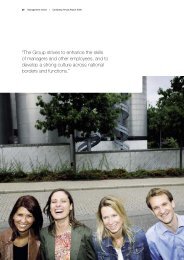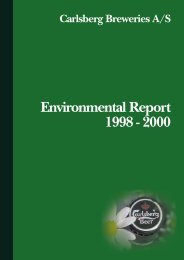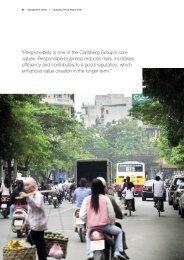Carlsberg Annual Report - Carlsberg Group
Carlsberg Annual Report - Carlsberg Group
Carlsberg Annual Report - Carlsberg Group
You also want an ePaper? Increase the reach of your titles
YUMPU automatically turns print PDFs into web optimized ePapers that Google loves.
<strong>Carlsberg</strong> <strong>Annual</strong> <strong>Report</strong> 2011 119<br />
NOTE 41 Accounting policies – continued<br />
The useful life is reassessed annually. When changing the amortisation<br />
period due to a change in the useful life, the effect on the amortisation is<br />
recognised prospectively as a change in accounting estimates.<br />
Amortisation is recognised in the income statement under cost of sales,<br />
sales and distribution costs, and administrative expenses to the extent that<br />
amortisation is not included in the cost of self-constructed assets.<br />
Impairment losses of a non-recurring nature are recognised in the income<br />
statement under special items.<br />
Tangible assets<br />
Property, plant and equipment. Land and buildings, plant and machinery,<br />
fixtures and fittings, and other property, plant and equipment are measured<br />
at cost less accumulated depreciation and impairment losses.<br />
Cost comprises the purchase price and any costs directly attributable to<br />
the acquisition until the date when the asset is available for use. The cost<br />
of self-constructed assets comprises direct and indirect costs of materials,<br />
components, subsuppliers, wages and salaries, and capitalised borrowing<br />
costs on specific or general borrowing attributable to the construction of the<br />
asset. The present value of estimated liabilities related to dismantling and<br />
removing the asset and restoring the site on which the asset is located is<br />
added to the cost of self-constructed assets if the liabilities are provided for.<br />
Where individual components of an item of property, plant and equipment<br />
have different useful lives, they are accounted for as separate items, which<br />
are depreciated separately.<br />
The cost of assets held under finance leases is stated at the lower of fair<br />
value of the assets and the present value of the future minimum lease payments.<br />
For the calculation of the net present value, the interest rate implicit<br />
in the lease or an approximation thereof is used as the discount rate.<br />
Subsequent costs, e.g. in connection with replacement of components of<br />
property, plant and equipment, are recognised in the carrying amount of the<br />
asset if it is probable that the costs will result in future economic benefits<br />
for the <strong>Group</strong>. The replaced components are derecognised in the statement<br />
of financial position and recognised as an expense in the income statement.<br />
Costs incurred for ordinary repairs and maintenance are recognised in the<br />
income statement as incurred.<br />
Property, plant and equipment, including assets held under finance leases,<br />
are depreciated on a straight-line basis over the expected useful lives of the<br />
assets. The expected useful lives are as follows:<br />
Buildings<br />
Technical installations<br />
Brewery equipment<br />
Filling and bottling equipment<br />
Technical installations in warehouses<br />
On-trade and distribution equipment<br />
Fixtures and fittings, other plant and equipment<br />
Returnable packaging<br />
Hardware<br />
Land is not depreciated.<br />
20-40 years<br />
15 years<br />
15 years<br />
8-15 years<br />
8 years<br />
5 years<br />
5-8 years<br />
3-10 years<br />
3-5 years<br />
The basis of depreciation is calculated on the basis of the cost less the<br />
residual value and impairment losses. The residual value is determined at<br />
the acquisition date and reassessed annually. If the residual value exceeds<br />
the carrying amount, depreciation is discontinued.<br />
When changing the depreciation period or the residual value, the effect<br />
on the depreciation is recognised prospectively as a change in accounting<br />
estimates.<br />
Depreciation and minor impairment losses are recognised in the income<br />
statement under cost of sales, sales and distribution costs, and administrative<br />
expenses to the extent that depreciation is not included in the cost of<br />
self-constructed assets.<br />
Significant impairment losses of a non-recurring nature are recognised in the<br />
income statement under special items.<br />
Investments in associates. Investments in associates are recognised according<br />
to the equity method and measured at the proportionate share of the entities’<br />
net asset values calculated in accordance with the <strong>Group</strong>’s accounting policies<br />
minus or plus the proportionate share of unrealised intra-<strong>Group</strong> profits and<br />
losses and plus the carrying amount of goodwill.<br />
Investments in associates with negative net asset values are measured at<br />
DKK 0. If the <strong>Group</strong> has a legal or constructive obligation to cover a deficit<br />
in the associate, the deficit is recognised under provisions.<br />
Any amounts owed by associates are written down to the extent that the<br />
amount owed is deemed irrecoverable.<br />
On acquisition of investments in associates, the acquisition method is used,<br />
cf. the description under Business combinations.<br />
Inventories. Inventories are measured at the lower of weighted average<br />
cost and net realisable value.<br />
Goods for resale and raw materials and consumables are measured at cost,<br />
comprising purchase price and delivery costs.<br />
Finished goods and work in progress are measured at cost, comprising the<br />
cost of raw materials, consumables, direct wages and salaries and indirect<br />
production overheads. Indirect production overheads comprise indirect materials<br />
and wages and salaries, and maintenance and depreciation of production<br />
machinery, buildings and equipment, and production administration and<br />
management.<br />
The net realisable value of inventories is calculated as the sales amount less<br />
costs of completion and costs necessary to make the sale, and is determined<br />
taking into account marketability, obsolescence and development in expected<br />
sales price.<br />
Receivables. Receivables are measured at amortised cost less impairment<br />
losses. Receivables are written down for bad debt losses on the basis of<br />
customers’ anticipated ability to pay and expectations of any changes to this<br />
ability, taking into account historical payment patterns, terms of payment,<br />
customer segment, creditworthiness and prevailing market conditions in the<br />
individual markets.<br />
Objective indication of impairment is assessed for a portfolio of receivables<br />
when no objective indication of individual impairment losses exists. The portfolios<br />
are based on on-trade and off-trade customers and on-trade receivables<br />
and on-trade loans. The objective indications used for portfolios are based on<br />
historical experiences and actual market developments.<br />
Impairment losses are calculated as the difference between carrying amount<br />
and net realisable value, including the expected net realisable value of any<br />
collateral provided.<br />
Regarding loans to the on-trade, any difference between present value and<br />
the nominal amount at the loan date is treated as a prepaid discount to the<br />
customer, which is recognised in the income statement in accordance with<br />
the terms of the agreement. The market interest rate is used as the discount<br />
rate, corresponding to the money market rate based on the maturity of the<br />
loan with the addition of a risk premium. The effective interest rate on these<br />
loans is recognised in other operating income. The amortisation of the difference<br />
between the discount rate and the effective interest rate is included as a<br />
discount in revenue.<br />
Construction contracts. Construction contracts (real estate projects) are<br />
measured at the contract revenue of the work performed less progress billings<br />
and anticipated losses.<br />
The contract revenue is measured by reference to the percentage of completion<br />
at the end of the reporting period and total expected revenue from the<br />
contract. The percentage of completion is determined on the basis of an


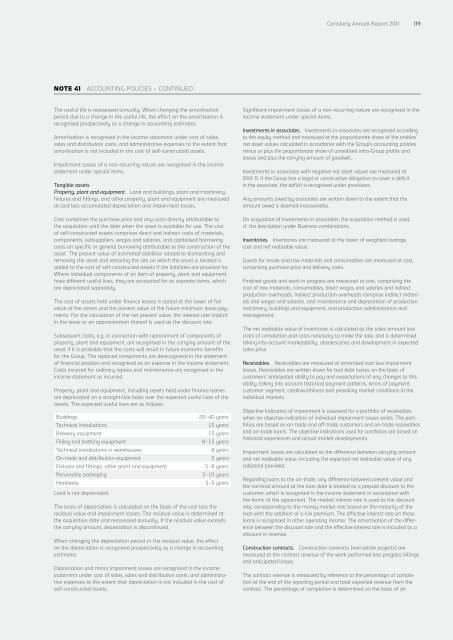
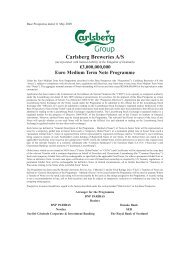
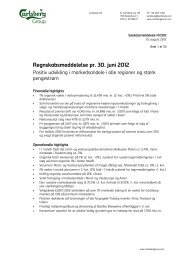

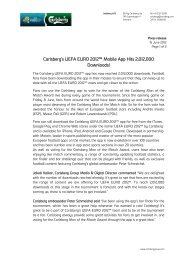
![[Name and Address] - Carlsberg Group](https://img.yumpu.com/49766377/1/184x260/name-and-address-carlsberg-group.jpg?quality=85)

![[Name and Address] - Carlsberg Group](https://img.yumpu.com/49015962/1/184x260/name-and-address-carlsberg-group.jpg?quality=85)
